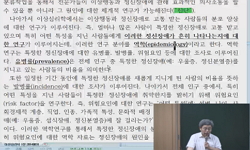A novel is prose of a fictional story based on imagination. Every novel has a narrator who delivers a story. Therefore, learners should understand who describes the world inside a novel, in other word, which character a narrator is focusing on when de...
http://chineseinput.net/에서 pinyin(병음)방식으로 중국어를 변환할 수 있습니다.
변환된 중국어를 복사하여 사용하시면 됩니다.
- 中文 을 입력하시려면 zhongwen을 입력하시고 space를누르시면됩니다.
- 北京 을 입력하시려면 beijing을 입력하시고 space를 누르시면 됩니다.

서술자를 통한 소설교육방법 연구 - 이상의 「날개」를 중심으로- = A Study on the Novel Education Method through the Narrator -Focusing on Wings of Yi, Sang-
한글로보기부가정보
다국어 초록 (Multilingual Abstract)
A novel is prose of a fictional story based on imagination. Every novel has a narrator who delivers a story. Therefore, learners should understand who describes the world inside a novel, in other word, which character a narrator is focusing on when delivering a story. Reading a novel through a narrator is an activity that learners form meaning by directly participating in communication of texts. Learners can have an active attitude when forming meanings by comparing the contents of a novel relevant to its point of view with his or her own thoughts. However, current education on the point of view of novels is being conducted in a formal and static way, depending on the Brooks and Warren``s Four-Term Typology. Consequently, many learners mistake the ``author`` of a novel for the ``narrator``, even though an author exists outside of the texts whereas a narrator exists inside the texts. This mistake can be considered to result from flawed education on the point of view of novels. In this article, an alternative method of education on the point of view focusing on the narrator is reviewed through ``Wings`` of Yi Sang. If instructors teach the point of view and narration separately based on the concept of focalization in novel education, learners will be able to easily understand semantic structure of a novel and how the view of the world of an author is realized. In addition, with being trained how to compare two novels with different narrative attitudes in focalization education, learners can acquire influences of an attitude of a narrator on a novel and learn the aspects of focalization.
참고문헌 (Reference)
1 로버트 험프리, "현대소설과 의식의 흐름" 형설출판사 1984
2 최시한, "현대소설 시점의 시학" 새문사 1996
3 권영민, "한국현대문학대사전" 누리미디어 2004
4 구수경, "한국소설과 시점" 아세아문화사 1996
5 이상, "이상문학전집 2" 문학사상사 2002
6 한용환, "소설학 사전" 문예출판사 1999
7 S 리먼 캐넌, "소설의 현대시학" 예림기획 1999
8 나병철, "소설의 이해" 문예출판사 1998
9 F.K.STANZEL, "소설의 이론" 탑출판사 1990
10 선주원, "소설교육의 원리와 방법" 새미 33-34, 2003
1 로버트 험프리, "현대소설과 의식의 흐름" 형설출판사 1984
2 최시한, "현대소설 시점의 시학" 새문사 1996
3 권영민, "한국현대문학대사전" 누리미디어 2004
4 구수경, "한국소설과 시점" 아세아문화사 1996
5 이상, "이상문학전집 2" 문학사상사 2002
6 한용환, "소설학 사전" 문예출판사 1999
7 S 리먼 캐넌, "소설의 현대시학" 예림기획 1999
8 나병철, "소설의 이해" 문예출판사 1998
9 F.K.STANZEL, "소설의 이론" 탑출판사 1990
10 선주원, "소설교육의 원리와 방법" 새미 33-34, 2003
11 김동환, "소설교육에서의 ‘시점’ 개념에 대한 반성적 고찰" 한국문학교육학회 (30) : 393-421, 2009
12 최시한, "소설, 어떻게 읽을 것인가" 문학과지성사 2010
13 G.Genette, "서사담론" 교보문고 1992
14 구인환, "문학교육론" 삼지원 2007
15 O'Neil, P., "담화의 연구" 예림기획 2004
16 교육부, "국어과 교육과정 해설: 국어" 대한교과서 268-269, 2001
17 교육부, "국어과 교육과정" 대한교과서 1998
18 교육과학기술부, "고등학교 교육과정 해설 국어" 대한교과서 5-, 2012
동일학술지(권/호) 다른 논문
-
새로운 리듬론의 탄생: 부재로서의 리듬, 율(律)의 이념 - 박슬기의 『한국 근대시의 형성과 율의 이념』에 대하여
- 한국문학언어학회
- 박현수
- 2015
- KCI등재
-
- 한국문학언어학회
- 송현주
- 2015
- KCI등재
-
김진영 외, <필사본 고전소설의 연구> (역락, 2014)
- 한국문학언어학회
- 유춘동
- 2015
- KCI등재
-
두암(斗菴) 김약련(金若鍊)의 한글 가사와 시조 - 노부탄(老婦歎), 답부사(答婦詞), 과폐탄(科弊歎), 소학가(小學歌), 육가(六歌) -
- 한국문학언어학회
- 백두현
- 2015
- KCI등재
분석정보
인용정보 인용지수 설명보기
학술지 이력
| 연월일 | 이력구분 | 이력상세 | 등재구분 |
|---|---|---|---|
| 2026 | 평가예정 | 재인증평가 신청대상 (재인증) | |
| 2020-01-01 | 평가 | 등재학술지 유지 (재인증) |  |
| 2017-01-01 | 평가 | 등재학술지 유지 (계속평가) |  |
| 2013-01-01 | 평가 | 등재 1차 FAIL (등재유지) |  |
| 2010-01-01 | 평가 | 등재학술지 유지 (등재유지) |  |
| 2007-01-01 | 평가 | 등재학술지 선정 (등재후보2차) |  |
| 2006-01-01 | 평가 | 등재후보 1차 PASS (등재후보1차) |  |
| 2004-01-01 | 평가 | 등재후보학술지 선정 (신규평가) |  |
학술지 인용정보
| 기준연도 | WOS-KCI 통합IF(2년) | KCIF(2년) | KCIF(3년) |
|---|---|---|---|
| 2016 | 0.57 | 0.57 | 0.51 |
| KCIF(4년) | KCIF(5년) | 중심성지수(3년) | 즉시성지수 |
| 0.53 | 0.5 | 0.949 | 0.17 |




 KCI
KCI KISS
KISS






